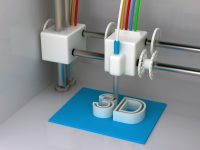Categories
- Additional Insured
- ChildrensProducts
- Claims Made
- Cyber Insurance
- Dietary Supplements and Nutraceuticals
- Ecigarettes
- Firearms Insurance
- Food Products
- Foreign Products Liability
- Foreseeable Misuse
- Frivolous Lawsuits
- General Liability
- Industrial
- Infographics
- Intellectual Property
- Looking ahead
- Marijuana Liability
- Medical Products
- Mutual Indemnification
- Nano Technology
- News
- Online Sellers Insurance Requirements
- Outsourcing
- Piercing The Corporate Veil
- Pollution Liability
- Product liability
- Product Recall
- Retail Chain Store
- Start-Up Business
- Statute of Repose
- Surplus Lines Insurance
- Technology
3-D Printing Defects and Product Liability

Technology is outpacing the legal system
I’ve posted several articles in the last few years about the future of 3-D printing, but it seems the future is already here. The healthcare and aerospace industries are currently the two main making use of 3-D printing, but the automobile, electronics and food industries are moving along quickly. There’s almost nothing that hasn’t been printed using 3-D technology, including human tissue.
However, lawmakers haven’t been able to keep up the pace of 3-D printing and other emerging technologies. Legislation is evolving, but it’s far from clear yet what product liability standards apply to 3-D printed products. Of the three product liability theories (strict liability, negligence and breach of warranty), it’s strict liability that holds manufacturers liable for injuries caused by a defect, regardless of who is at fault.
Legislators will have to get busy because business using this technology is booming. Estimated revenue for the international 3-D printing market is estimated to reach $35.4 billion in 2020, and to more than double the predicted $15.9 billion for 2017.
So many participants, so little clarity
Given how many participants are engaged in the chain of production of 3-D technology, it may be difficult to determine who in the design and manufacturing process is responsible for defects and flaws in the final product. It could be a challenge to apply product liability law to 3-D printing services and marketplaces because they are creating products based on designs from third parties.
Could the printer manufacturer or product maker be held responsible for defects, caused by a problem with the printer’s scanner or with the raw printing material? Other parties who could be considered liable are the printing service, the designer of the digital file, or even the consumer designing or printing on his/her own.
And others at risk for liability include hospitals and/or doctors who supply 3-D printed medical devices and pharmacists who distribute 3-D printed drugs.
A two-edged sword of 3-D printing is consumers’ ability to design and print the products they want, which blurs the lines as to whom the designer is. Digital designs for 3-D products can easily be uploaded anonymously to the cloud, where they can be accessed and modified by anyone.
Blurry lines
This leads us to the notion of creating custom products using 3-D technology. Despite the benefits this offers, it opens up another potential liability can of worms: how to ensure the reliability of custom products. Detecting flaws in the manufacturing process could be more difficult when every 3-D printed object is slightly varied.
manufacturing process could be more difficult when every 3-D printed object is slightly varied.
And what about the person who isn’t actually in the business of manufacturing and selling a particular product? Strict liability wouldn’t pertain to hobbyists or businesses that print different 3-D products from day to day. But negligence, which carries a higher standard of proof, could conceivably be applied to a defective product manufactured by such people.
It will be interesting to see how product liability laws unfold when the first cases revolving around 3-D printing technology are litigated.
Source: Alex Kramer. “3-D Printing Leaps Ahead of Product Liability Law.” www.bna.com. 28 Sept., 2016.
-
 Click the Button Below to Get Your
Click the Button Below to Get Your
No-Obligation Quotes from Among the
Top 18 Leading Insurance Carriers Today -
Recent Industry News
- Amazon Sellers and Vendors Strategy Including Insurance Requirements
- Walmart Sellers Insurance
- Product Liability Limit Requirements of Online Sellers
- State-by-State Product Liability Analysis of Laws Impacting Businesses
- Children’s Product Liability: Strange Claims and Need for Insurance
- Product Liability vs. Environmental Insurance for the Chemical Industry
- Product Liability in the 3D Printing Industry: New Materials and Their Significance
- Product Liability Concerns in Agricultural Equipment Enhanced with Artificial Intelligence
- Navigate Product Liability in Battery and Solar Industry
- Cyber Risk Insurance Is Essential Business Insurance in Today’s Modern World
Monthly News Archives
